Related Research Articles
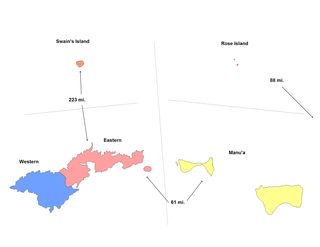
This is a list of the buildings, sites, districts, and objects listed on the National Register of Historic Places in American Samoa. There are currently 31 listed sites spread across the three districts of American Samoa. There are no sites listed on the unorganized atoll of Swains Island.
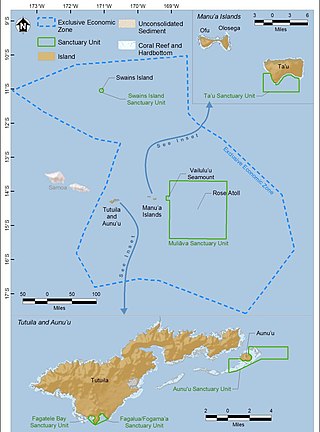
The National Marine Sanctuary of American Samoa is a federally-designated underwater area protected by the National Oceanic and Atmospheric Administration's (NOAA) Office of National Marine Sanctuaries. This sanctuary is the largest and most remote in the National Marine Sanctuary system. Spanning 13,581 sq mi, it is thought to be home to the greatest biodiversity of aquatic species of all the marine sanctuaries. Among them are expansive coral reefs, including some of the oldest Porites coral heads on earth, deep-water reefs, hydrothermal vent communities, and rare archeological resources. It was established as Fagatele Bay National Marine Sanctuary on April 29, 1986, it is thought to be home to the greatest biodiversity of aquatic species of all the marine sanctuaries. and then expanded and renamed in 2012.

Alvarado Area is a subsection of Wildcat Canyon Regional Park in Richmond, California and is a National Historic Place. It is located at the mouth of Wildcat Canyon in the Alvarado Area section. Between 1909 and 1923, Alvarado Park was a private park that was owned and operated by local residents. In 1923, it was donated to the city of Richmond. Later it was admitted into the East Bay Regional Park District.

Leone is the second-largest city on Tutuila Island's west coast. The village is on the south-west coast of Tutuila Island, American Samoa. Leone was the ancient capital of Tutuila Island. Leone was also where the Samoan Islands’ first missionary, John Williams, visited on October 18, 1832. A monument in honor of Williams has been erected in front of Zion Church. Its large church was the first to be built in American Samoa. It has three towers, a carved ceiling and stained glass. Until steamships were invented, Leone was the preferred anchorage of sailing ships which did not risk entering Pago Pago Harbor. Much early contact between Samoans and Europeans took place in Leone.

Government House, also known as Building No.1, Naval Station, Tutuila or Government House, U.S. Naval Station Tutuila, is a historic government building on the grounds of the former United States Naval Station Tutuila in Pago Pago, American Samoa. Built in 1903, it has served as a center of government on the island for much of the time since then. Government House was listed on the United States National Register of Historic Places in 1972, and was declared a National Historic Landmark in 1990.
Futiga is a village in the southwest of Tutuila Island, American Samoa. It is located inland, 7 miles (11 km) southwest of Pago Pago, between the villages of 'Ili'ili and Puapua. It is in Tualatai County.
Aʻasu or Āsu is a village on the north coast of Tutuila Island, American Samoa. It is located to the west of Fagasa and northwest of Pago Pago. It is one of multiple villages involved in an archaeological survey of the island. Aʻasu lies on Massacre Bay and can be reached from a hiking trail in Aʻasufou.
Allen Island or Allen's Island is a 450-acre (180 ha) private island which is part of St. George, Knox County, Maine, United States. it is located near the southeastern end of Muscongus Bay, roughly midway between the southernmost parts of the St. George's mainland, and Monhegan Island.
The Dugi Archeological Site is a prehistoric latte stone site on the north side of Rota Island in the Northern Mariana Islands. The site is a rare inland site that survived the intensive sugar cane development introduced by the Japanese during the South Seas Mandate period of the 1920s and 1930s. It consists of sixteen deteriorated latte stone structures on three high terraces. Some of the latte stones have fallen over and others are missing features normally found at these sites.
The A'a Village Site, designated "AS-34-33" by archaeologists, is an abandoned village site on the island of Tutuila in American Samoa. Located on a bay on the northwest coast of the island, the site was first surveyed by professional archaeologists in 1985. The site has four distinct areas, in which features interpreted as house foundations have been located, as have rock walls, grave sites, and platform mounds. The site was not known to be occupied within the living memory of nearby residents, and the size of trees in the site suggests it has been abandoned since the 1860s.
The Lau'agae Ridge Quarry is a prehistoric stone quarry on the eastern side of the island of Tutuila in the United States territory of American Samoa. It is located on a ridge above another archaeological site, the prehistoric village of Tulauta. The site includes a carpet of stone flakes, evidence of rough stonework, signs of habitation, and two tia'ave, oval stone platforms found in abundance on the island.
The Maloata Village Site is a prehistoric village site on the northwestern coast of the island of Tutuila in the United States territory of American Samoa. The archaeologically sensitive site includes a variety of stone features, principally stone fences and retaining walls, with evidence from excavation of human habitation. Radiocarbon dating from one of its test pits yielded a date range of CE 550–1000, identifying the site as one of the oldest known on the island. According to oral tradition, the Maloata area was reserved for use by relatively high-status chieftains.
Site As-31-72 is a prehistoric archaeological site on the island of Tutuila in the United States territory of American Samoa. Located on the Tafuna Plain, an inland area on the western half of the island, its principal feature is a long stone wall, 300 metres (980 ft) long with a maximum height of 5.4 metres (18 ft). Set on sloping ground, the top of the wall is roughly level, and is only 2.8 metres (9.2 ft) high at the upper end of the slope. Platforms and other features have been identified during archaeological examination of the structure and its surroundings in the 1990s. Its purpose is unknown; the researchers conjecture it was built because of warfare.
The Tulauta Village Site is a prehistoric village site in far eastern Tutuila, the largest island of American Samoa. The site includes 10-13 house sites, a number of grave site, and other features, including stone enclosures interpreted as pig sties, fire pits, and walls. An upright basalt slab was found, which may have been of local religious significance. Early archaeological testing took place here in the 1970s, with more extensive examinations in the 1980s and 1990s. A large number of basalt stone flakes led an early researcher to speculate that it was a quarry site; it is more likely the inhabitants were working stone quarried from a site on the ridge above.
Old Vatia is a prehistoric village site on the north side of Tutuila, the largest island of American Samoa. The site is located on the Faiga ridge, above the modern village of Vatia in the National Park of American Samoa. It is stretched linearly along the ridge, with terraced areas that have features such as stone house foundations and pavement. The site, believed to have been occupied c. 1300–1750, is one of the island's few upland village sites. It was first identified in the 1960s and recorded in detail in 1989.
The Tataga-Matau Fortified Quarry Complex, designated Site AS-34-10, is a major archaeological complex on Tutuila, the largest island of American Samoa. Located in an upland area on the western side of the island above the village of Leone, the complex consists of a series of basalt quarries and structures that archaeologists have interpreted as having a military defensive purpose. The site has been known since at least 1927, and was first formally surveyed in the 1960s. Features of the site include extraction pits, from which basalt was quarried for the manufacture of stone tools and weapons, as well as domestic features such as grinding stones. Archaeologists in 1985 noted that some of the features of the site were, including trenches and terracing, were made in areas that were unsuitable for the production of stone tools, and closely resemble known military defensive structures in other areas of the Samoan islands. The site extends along with a network of ridges for more than 1.4 kilometres (0.87 mi). Radiocarbon dating of elements of the site indicate periods of occupation and/or use from c. 200 CE to the period of European contact.
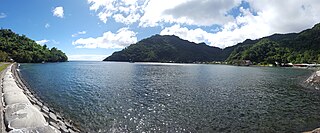
Fagasā is a village in the Eastern District of Tutuila Island in American Samoa. The village lies by Fagasa Bay, on the north shore of the island. Its name is Samoan and translates to "Forbidden Bay." The village borders the Tutuila-section of National Park of American Samoa. The trailhead to Mount ʻAlava is located near the village by Fagasa Pass.
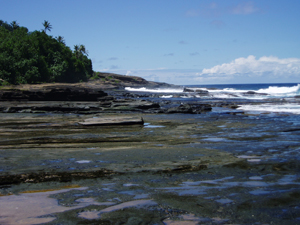
Taputimu is a village in southwestern Tutuila Island in American Samoa. It is the nearest village to the Fagatele Bay National Marine Sanctuary, although the main access is from the neighboring village of Futiga. It is home to Leala Shoreline National Natural Landmark and Leala Sliding Rock. Leala Sliding Rock is a natural rock formation between Vailoatai and Taputimu, which is a scenic landmark as well as a natural playground or slide. It was created by the ebb and flow of the ocean; the erosion has created a smooth shoreline site. It is located in Tualatai County in the Western District of Tutuila.
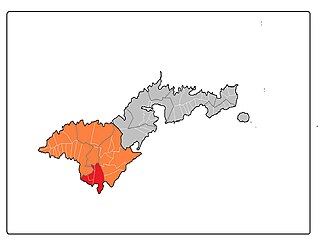
Tuālā-tai County is one of the five counties that make up the Western District of American Samoa.

Larsen Bay is a bay in the Western District, American Samoa. Comparable to its neighboring Fagatele Bay, Larsen Bay serves as a vital habitat for marine biodiversity. Larsen Bay, covering approximately 0.46 square miles, is located east of Fagatele Bay, stretching from Steps Point to Sail Rock. The bay features a steep descent to depths exceeding 500 meters and is characterized by rich coral coverage and diverse marine species.
References
- 1 2 "National Register Information System". National Register of Historic Places . National Park Service. July 9, 2010.
- ↑ "Final Project Reports for Tulauta and Fagatele Bay Prehistoric Villages and Leone Bay Petroglyphs, December 1985" (PDF). University of Hawaii. Retrieved 2015-05-21.
- ↑ Churchill, W. (1913). "Geographical Nomenclature of American Samoa". Bulletin of the American Geographical Society, 45(3), page 191. Retrieved on December 6, 2024, from https://doi.org/10.2307/199273.

